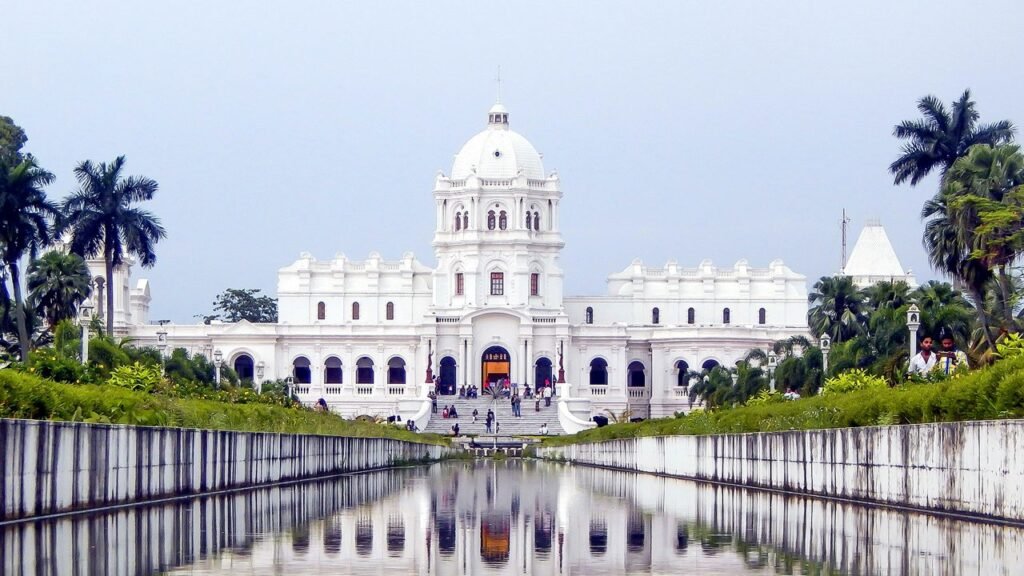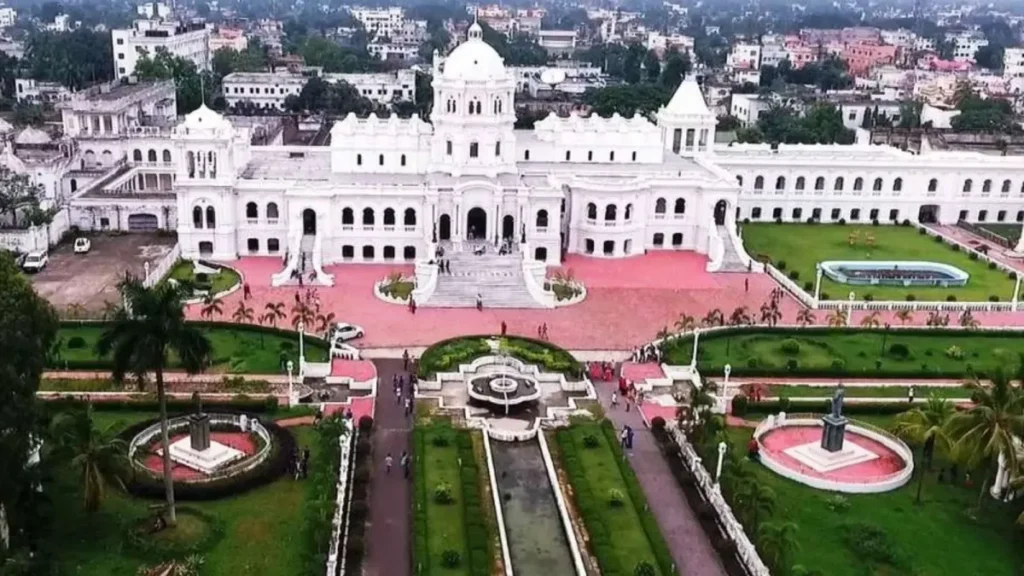Ujjayanta Palace is a cultural gem and historic marvel in Agartala, Tripura, standing testament to the region’s royal grandeur, vibrant culture, and evolving role as a premier tourist destination. The palace’s blend of Indo-Saracenic architecture, lush gardens, and a rich narrative of dynastic history offer a compelling journey through Tripura’s heritage for visitors and researchers alike.
Ujjayanta Palace, set in the heart of Agartala, is one of Northeast India’s most important cultural and architectural landmarks. Built in the early 20th century, this majestic palace not only housed Tripura’s royal family but also echoed with the footsteps of poets, policymakers, and cultural icons. Today, Ujjayanta Palace has evolved into a state museum, welcoming scores of tourists to immerse themselves in Tripura’s grand past and vibrant present.
Key Details:
| Feature | Details |
|---|---|
| Location | In the heart of Agartala city, Tripura |
| Built By | Maharaja Radha Kishore Manikya |
| Year of Construction | 1901 |
| Architecture | Indo-Saracenic style, Mughal gardens, three domes (each 86 feet high), tile floors, wooden ceilings |
| Main Attractions | State Museum, Throne Room, Durbar Hall, Library, Reception Hall, Chinese Room, musical fountain, night floodlights |
| Gardens & Surroundings | Mughal-style gardens with fountains, two large artificial ponds, several Hindu temples nearby |
| Recommended Visit Duration | 2 hours |
| Visiting Days | Open Tuesday to Sunday (closed on Mondays) |
| Visiting Time | 10:00 am to 5:00 pm |
| Entry Fee | ₹10 per person |
| Best Time to Visit | October to March (pleasant weather for garden walks and sightseeing) |
| Nearest Airport | Maharaja Bir Bikram Airport, Agartala (approx. 12 km away) |
| Nearest Railway Station | Agartala Railway Station (approx. 5.5 km away) |
| Local Transport | Cabs, auto-rickshaws, buses available from airport/railway station/city center |
| Nearby Attractions | Jagannath Temple (2 km), Kamalasagar Kali Temple (26 km), Sepahijala Wildlife Sanctuary (31 km), Neermahal (50 km) |
| Photography Policy | Permitted in gardens/exteriors; restrictions likely for interiors/museum artifacts |
| Entry Cost Estimate | Domestic: ₹10; Local transport (one-way): approx. ₹100-200 from airport, ₹50-100 from railway station (subject to change) |
- Nearby Attractions: Religious temples, wildlife sanctuary, and architectural marvel Neermahal, all within driving distance.
- Main Things to Do: Tour the museum, walk through Mughal gardens, photograph the lavish exteriors, observe palatial architecture, and enjoy special events/fountains.
- Cost of Travel: Local cabs/auto from airport to palace may cost ₹100-200, and from railway station ₹50-100; entry fee ₹10 per person.
A Brief History: From Royal Residence to Museum
The story of Ujjayanta Palace traces back to 1862 when King Ishan Chandra Manikya first built a royal residence on the outskirts of Agartala. After the 1897 Assam earthquake destroyed the original structure, Maharaja Radha Kishore Manikya rebuilt the magnificent palace between 1899 and 1901, investing over 10 lakh rupees, a fortune of the era. The palace served as the regal seat for the Manikya dynasty until Tripura’s integration into India in 1949.
Its name, “Ujjayanta,” meaning “Palace of Victory,” was bestowed by the great poet Rabindranath Tagore, a frequent guest of the royal court. The site became the Legislative Assembly in 1972 and remained so until 2011, after which it began its new chapter as a museum. In 2013, the palace was formally inaugurated as the Tripura State Museum, and its heritage status was secured after public advocacy.
Architectural Splendor: Style and Features
Designed by Sir Alexander Martin of Martin and Burn Co., Ujjayanta Palace exemplifies Indo-Saracenic architecture, a melting pot of Mughal, Roman, and British styles. Its two-storied, white-painted façade supports three majestic domes, the central one rising to 86 feet. The palace features:
- Ornate tile flooring and curved wooden ceilings crafted by Chinese artisans.
- Opulent throne and Durbar halls, a library, and reception chambers.
- Spectacular Mughal-style gardens, musical fountains, and twin artificial ponds on sprawling grounds of about 1 km² (250 acres).
- Proximity to numerous Hindu temples, highlighting the deep spiritual ties of the region.
Recent enhancements like nighttime floodlights and musical fountains add to its allure and visitor experience.

Cultural Heritage and Collections
Beyond regal architecture, Ujjayanta Palace is a treasure trove of culture and tradition. The state museum within showcases:
- Ethnographic artifacts, tribal crafts, art, and historical documents.
- Exhibits on local festivals, music, textile weaving traditions, and Tripura’s diverse indigenous communities.
- Galleries featuring temple models, sculptures, weapons, and royal memorabilia.
The museum is a vibrant center for cultural performances, research, and preservation of Tripura’s legacy.
Ujjayanta Palace as a Tourist Spot
Ujjayanta Palace stands as Tripura’s most popular tourist destination, drawing both domestic and international travelers. Its accessibility, historical gravitas, and curated exhibitions make it the crown jewel of Agartala’s attractions.
Highlights for Tourists
- Guided tours and language support for visitors.
- Tranquil lakes, lush gardens, and photogenic settings attract families, solo travelers, and history buffs.
- Located near Agartala’s bustling market and the Haora River, making it easy to combine sightseeing, shopping, and dining.
Visitor Experience
- Best visiting months: October–March, when the weather is pleasant.
- Annual growth in tourist numbers reflects its enduring charm and Tripura’s rising tourism profile.
- Weekend traffic-free zones and recent tourism initiatives promote a vibrant, safe atmosphere.
Recent Developments and News
Recently, Ujjayanta Palace has been in the news for several positive developments:
- The Tripura government has launched a “weekend tourism hub,” converting the palace’s surroundings into a car-free zone on weekends to boost visitor experience and local business.
- Special events such as International Museum Day and traditional Ker Puja rituals continue to attract dignitaries and the public, highlighting its cultural and religious importance.
There has also been heightened attention regarding protection of the palace interiors after controversy about filming and photography by influencers, underscoring ongoing efforts to balance promotion and preservation.
Revenue and Economic Impact
Tourism at Ujjayanta Palace is a significant source of revenue for Tripura. Key tourism and economic facts:
- In 2019, the palace drew more than 360,000 visitors (predominantly domestic tourists), with a robust 10%+ annual growth rate since 2014.
- Average tourist spending per trip is ₹1,712 for domestic visitors and ₹2,228 for foreign tourists, amounting to substantial economic inflow.
- Direct and indirect income multipliers further amplify the overall benefit to Agartala and the wider region.
Proactive investment in tourism infrastructure, marketing, and heritage conservation ensures continued economic returns while nurturing local identity.
Ujjayanta Palace: Location and How to Reach
Ujjayanta Palace is centrally located in Agartala, the capital city of Tripura. Getting there is simple via:
- Air: Agartala’s Maharaja Bir Bikram Airport (12 km from the palace) connects to major Indian cities.
- Rail: Agartala Railway Station links the city to Guwahati, Kolkata, and Delhi; the palace is a short cab or rickshaw ride away.
- Road: National and state highways connect Agartala to other cities in the North East; local buses, taxis, and auto-rickshaws provide last-mile access to the palace.
Nearby attractions include bustling markets, temples, and cultural venues, making Ujjayanta Palace a perfect base for exploring Tripura.
Spiritual and Mythological Significance
Ujjayanta Palace’s name and location are steeped in Hindu mythology, “Ujjayanta” is associated with Indra, the king of gods, symbolizing victory and prosperity. The palace complex is adjacent to temples of Lakshmi Narayan, Uma-Maheshwari, Kali, and Jagannath, reflecting its integration with local spiritual life.
Mythological motifs and temple festivals enrich the palace’s aura, making it a confluence of royalty, tradition, and piety.
FAQs about Ujjayanta Palace
Who built Ujjayanta Palace?
Ujjayanta Palace was rebuilt between 1899 and 1901 by Maharaja Radha Kishore Manikya after the original palace (built by King Ishan Chandra Manikya in 1862) was destroyed by an earthquake in 1897.
What is the architectural style of the palace?
The palace features Indo-Saracenic architecture, blending Mughal, Roman, and British influences, and is famed for its domes, tiled floors, and Chinese-crafted ceilings.
What is the significance of the palace today?
Ujjayanta Palace now serves as Tripura’s state museum, exhibiting the region’s art, history, and cultural traditions. It is also a major tourist attraction and occasional state event venue.
What are the major attractions inside Ujjayanta Palace?
Key attractions inside the palace include the throne room, Durbar hall, reception chambers, Chinese Room, gallery displays, and exquisitely landscaped gardens with fountains.
How does the palace contribute to Tripura’s tourism and economy?
With over 350,000 visitors annually and a direct multiplier on local tourism revenue, Ujjayanta Palace significantly enhances Tripura’s tourism, commerce, and cultural identity.
When is the best time to visit Ujjayanta Palace?
The ideal period to visit is between October and March, when the weather is enjoyable and the palace grounds are most vibrant.
Are there any restrictions for visitors inside the palace?
Photography and video recording inside the museum are currently restricted to protect the exhibits and heritage, with periodic reviews following public incidents.
Route Map to Ujjayanta Palace
- From the Airport: Exit Maharaja Bir Bikram Airport, take a cab or bus towards the city center (approx. 12 km).
- From Agartala Railway Station: Hire a cab or rickshaw for a 5.5 km ride to the palace.
- By Road: Follow National Highway 44 for direct access to Agartala; local transport will take you to the palace compound.
The palace is conveniently placed for easy access from all key transit points in Agartala.
The Future: Conservation and Sustainable Tourism
Ongoing restoration, digital initiatives, and tourism-friendly policies continue to enhance the Ujjayanta Palace experience for future generations. Local authorities, cultural bodies, and conservation agencies are working together to:
- Maintain and restore architectural features and museum exhibits.
- Promote sustainable, inclusive tourism that benefits local communities.
- Protect the site’s heritage while accommodating a growing visitor base through smart management practices.
As the pride of Tripura, Ujjayanta Palace is poised for a vibrant future at the intersection of history and modernity.
